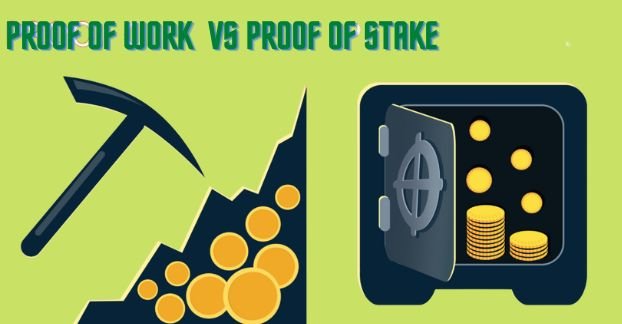Introduction: To understand what is Proof of Work V/S Proof of Stake, we need to understand how cryptocurrency are minined in the blockchain ecosystem. When we think of cryptocurrency, the first thing that comes to mind is decentralised systems. This decentralised system is the backbone of every cryptocurrency which are in existence today.
With this comes a question: If it’s decentralised, who will govern this ecosystem, so it performs correctly?
The Governance issue led to the development of two ecosystems called Proof of Work and Proof of Stake, which we will understand later.
Secrecy and security are the foundation of the blockchain ecosystem. To arrive at a consensus in validating any transaction led to the development of Proof of work and Proof of stake in the cryptocurrency system.

Table of Contents
- What is Proof of Work?
- What is Proof of Stake?
- As We understand Proof of Work and Proof of Stake:
- Conclusion:
- Frequently Asked Questions (FAQs)……….
What is Proof of Work?
This system was developed by Bitcoin cryptocurrency founder Satoshi Nakamoto first and then adopted by almost most of the current cryptos. The users of the Proof of Work system develop consensus to verify all the transactions inside the blockchain, ensuring that no false data blocks are incorporated into the chain to deceive other participants. This process is also called mining the crypto.
Proof of work is based upon the advanced mathematical form called cryptography. Due to this, Bitcoin and Ethereum are called cryptocurrencies. Cryptography uses complex mathematical equations that are so difficult and unique that only powerful computer devices can solve them. High-end ASIC computer devices that solve millions of calculations per second are employed in series together to solve equations. Once solved, these equations can’t be repeated, and the corresponding transactions are considered authentic and validated.
The Proof of work was a breakthrough system to validate entries in the blockchain, but as with most systems, it could be better. It not only requires high electricity consumption to run power-hungry computer devices. But it also limits the number of transactions it can process simultaneously. Miners who could afford to have these high-end computer devices were only able to solve equations. It leads to the formation of risk if some particular miner or group of miners together can control more than 51% of computer devices employed in the blockchain system. Then they can authenticate and validate some blocks twice and run the risk of duplication of crypto. But to own more than 51% of all machines employed for mining across the world for a particular blockchain is almost impossible.
This led to the development and adoption of Proof of Stake another way to authenticate and validate the transactions in the blockchain.
What is Proof of Stake?
This process revolves around staking. It is quite similar to a voting concept where one person votes. Here instead of participants, there are validators to confirm the transaction in the blockchain. Each validator stakes a certain amount of crypto behind the block they want to validate. Different blockchains have a different amount of fixed stake, which the validator must hold to participate in the process. The validator receives a reward in the form of cryptocurrency for verifying transactions in the blockchain.
Here it safeguards the interest of all validators if some particular validators have verified the wrong block as authentic. In that case, they risk losing the crypto staked by them for participating in the blockchain. This method ensures that all the transactions verified by the stakeholders are genuine and authentic.
Alternative to Proof of Work is Proof of Stake
The Proof of Stake system was designed as an alternative to Proof of Work. It addresses the requirement of huge electricity consumption problems, environmental impact and hurdle to owning a very expensive high-end computer to do the mining process. But it also has its drawback, as it requires huge investment upfront. To participate in the blockchain, one has to own a significant amount of crypto to stake. It involves a large upfront investment, again bringing people with deep pockets to participate. Participants which large control can validate the same copy twice as its present on both sides of the network. One who stakes crypto to validate another one who solves the complex equation to be eligible for a reward.
Thus, it runs the risk of double spending their crypto coins if the validator is on both sides. But to gain that advantage, one must have more than 51% of crypto to stake in the blockchain, which is almost impossible.

As We understand Proof of Work and Proof of Stake:
One need to see both pros and cons of both mining system for cryptocurrency. Both Proof of Work and Proof of Stake has its own advantage and disadvantage depending on its use case. Different blockchains have adopted these mining systems based on their end use. Bitcoin is on Proof of Work based mining system whereas Ethereum blockchain is based on proof work which is going to be shifting on proof of stake system in future.
Now let see Pros and Cons of Proof of Work
| Pros of Proof of Work | Cons of Proof of Work |
| Upfront high cost makes it highly secure | High Electricity Consumption |
| Network is open and decentralised | Double Spending |
| Consensus mechanism to have been proven at scale | Less Scalable and generate large amount of Ewaste as computer machiens becomes obsolete very fast |
Proof of Stake Pros and Cons
| Pros of Proof of Stake | Cons of Proof of Stake |
| Less Environmental Impact as less electricity requirement | Upfront high cost to own crypto for making a stake as a validator |
| Fast and large number of transactions at a time and highly scalable | Hasn’t tested and proven at full scale and very few crypto chains are using it |
| Economic incentive as network fee given to stake holder for validating transactions in the blocks | Not as secure and tamper resistant as Proof of Work |
Conclusion:
Ultimately, which system is better, Proof of Work or Proof of Stake depends on individual use cases. Both systems have their pros and cons. Neither system is 100% perfect and has flaws and limitations.
In proof of stake, consensus is reached by requiring participants to place cryptocurrencies behind the new block they wish to add to a cryptocurrency’s blockchain. Meanwhile, Proof of work achieves consensus by requiring participants to spend computational power using high-end computer devices and a large amount of electricity to generate a new valid block.
Proof of work is more secure and robust, but it has cost in terms of environmental impact. High electricity consumption requirement and large investment for high-end computing devices.
Proof of stake is less secure and robust, but it comes with the benefits of many transactions carried at a time. It’s more scalable and has fewer environmental impacts. But it also has limitations that participants with a certain amount of crypto holding, i.e., large investment in crypto upfront. Then only one can participate as a validator in the blockchain.
Frequently Asked Questions (FAQs)……….
How is ProofProof of work different from ProofProof of stake?
With proof-of-stake (POS), cryptocurrency owners validate block transactions based on the number of staked coins. Proof-of-stake (POS) is an alternative to Proof-of-work (POW), the original consensus mechanism used to validate a blockchain and add new blocks.
In Proof of stake, the system relies on staking, while Proof of work relies on mining. Proof of Stake is possible by pledging the crypto owned by the validator to participate in the validations process. And proof of work uses many computers to authenticate and validate transactions.
Which system uses less energy Proof of Stake or Proof of Work?
Proof of stake requires significantly less energy to validate a transaction happening in the block. It relies on developing consensus by staking crypto owned by the validator. Thus, doesn’t require powerful high computers to solve complex mathematical equations and reduce the requirement for electricity.
Which System is more Robust and Stable, Proof of Work or Proof of Stake?
Proof of Work is a more robust and stable system. It requires many high-end computer devices to solve equations in the blocks for verifying the transaction. In turn, there is less chance of a duplicate entry for transactions or bad data block.
Can Proof of stake replace proof of work?
Yes, with time, as blockchain mechanisms evolve and mature with more advancements in cryptography, Proof of stake will replace the Proof of work system. As it is more environmentally friendly, requires less electricity and gives more choices for validators to participate in the process.
Will proof-of-work go away?
Yes, it will go away. as ProofProof of work adoption is decreasing with every passing. Ethereum no longer uses proof-of-work as part of its consensus mechanism. Instead, it uses proof-of-stake. Bitcoin blockchain still uses the Proof of work mechanism. It is going away due to its severe environmental impact as it requires a huge amount of electricity to run devices to mine the blocks. Also, due to the large number of computer machines running continuously they
Now that you understand the mining process for cryptocurrency, you might be interested in learning how it is stored in a Crypto wallet. To learn more about this, you can read here…


Pingback: What is Crypto Wallet, and What is a crypto address used for?? -
Thanks!